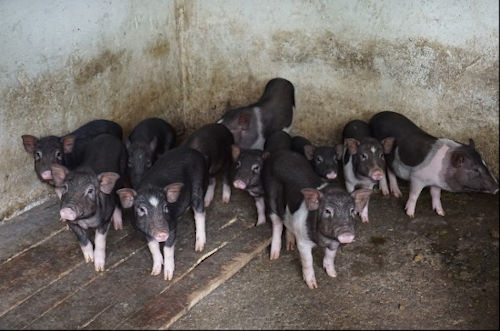By Stephanie Buck
In a small town in northern Vietnam, where the green hillsides crest and slope in unending layers, Nguyen Thi Tuyet has seen a lot of change in her 65 years. But the one constant has been that life in her village centers on agriculture.
Most people in the Vo Nhai district in Thai Nguyen province spend their days raising pigs, chickens, or cattle, and tending to tea, corn, or rice field paddies. But last year, swine fever raced through all 63 provinces in Vietnam. More than 23 percent of the country’s total pig population died. In a country where pork makes up three-quarters of total meat consumption and accounts for nearly 10 percent of the agricultural sector, this was a huge problem. And it was felt deeply in Ms. Tuyet’s community, where more than 360 families depend on pigs to make a living.
No one could have predicted the disease would sweep the country like it did. And while this outbreak was not a zoonotic disease (the kind of disease that jumps from animals to people) like COVID-19 is believed to be, it raises the importance of more environmentally and zoologically responsible practices to prevent future outbreaks. It also highlights the challenge of motivating farmers to adopt a new approach.
In many rural areas in Vietnam, pigs are raised in structures made of brick and concrete, often annexed to farmers’ homes. The amount of pigs in one of these annexes varies, but there can be as many as 30 pigs in one small space. The floors are typically made of cement, which damages the pigs’ hooves. The nonporous flooring also means that when the animals relieve themselves, there is nowhere for the waste to go. They often get sick from sitting in their own mess, which then spurs a need for antibiotics. Farmers resort to hosing down the sties, washing the waste out once or twice a day or moving it to biogas cellars. Even with this, the stink is inescapable. And the waste that gets washed out? It flows into the street gutters, and eventually, the river. The runoff contaminates local water supplies and upsets the ecological balance of river, leading to harmful algal blooms, dead zones, and the destruction of river wildlife.

Pigs in a traditional sty. Credit: Center 4 Creativity & Sustainability.
As a former chairwoman of the Vo Nhai Women’s Union, Ms. Tuyet is passionate about community development. Although she retired in 2010, she hasn’t stopped working. Last year, she attended a training workshop in Ba Vi National Park, near Hanoi, about sustainable farming practices. While there, Ms. Tuyet and more than 20 others learned more about the problems that concrete-floored pigsties cause, and how a combination of science-based techniques and social marketing could pave the way for healthier, environmentally-friendly alternatives. The training was part of a series called Campaigning for Conservation (C4C) that Rare, an environmental nonprofit organization, runs with the support of Germany’s International Climate Initiative, to help practitioners solve social and environmental challenges facing their communities. Rare conducted the training in partnership with the Center 4 Creativity & Sustainability (CCS), a local agricultural and community development organization, as well as A Growing Culture, an organization that supports farmer-led solutions.
Click here to see more...